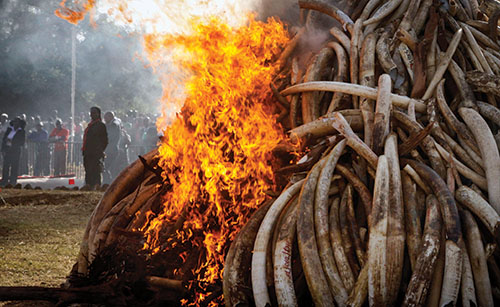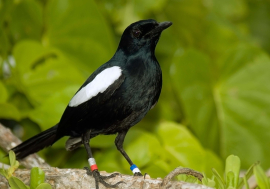Africa Watch
Wildlife crime at record high
By Pavithra Rao

The situation is dire: slaughtering wild animals for their horns and tusks is mushrooming and the statistics are so worrisome that experts are calling for a crackdown on wildlife crime.
This was the focus of this year’s Wangari Maathai Day, commemorated on 3 March and named after the late Kenyan Nobel Prize Laureate and founder of the Green Belt Movement, who was known for her passion and struggle to
preserve nature.
The event began with a grand gesture: Kenyan President Uhuru Kenyatta presided over the burning of 15 tons of elephant tusks seized from poachers to highlight the need to end the $200 billion illicit trade taking place in Africa, especially the killing of elephants for their tusks, rhinos for their horns and the illegal trafficking of great apes. Banners proclaiming, “Wildlife crime is serious; let’s get serious about wildlife crime” were prominently on display.
The Convention on International Trade in Endangered Species of Wild Fauna and Flora says poaching is steadily threatening the population of elephants and rhinos in Africa. In South Africa, for example, rhino poaching has risen drastically from 10 cases in 2006 to 1,215 in 2014. Back in 2011, black rhinos were already declared extinct as a result of poaching.
However, it’s not just the elephants and rhinos that are under threat. Great apes, including chimpanzees, orangutans, gorillas and bonobos are also being illegally trafficked. The UN Environment Programme Great Apes Survival Partnership (UNEP-GRASP) says that great apes are sold for meat and leftover body parts, such as limbs, heads and even bones, are then traded for use in medicine.
In addition, these animals are being sold to satisfy a growing demand for exotic pets or for use in circuses and zoos. Elephants, rhinos and great apes play an important role in maintaining healthy ecosystems and their absence could have serious repercussions on the biodiversity of key regions.
UN Secretary-General Ban Ki-moon noted the gravity of the situation during a speech for International Wildlife Day: “Combating this crime is not only essential for conservation efforts and sustainable development; it will contribute to achieving peace and security in troubled regions where conflicts are fuelled by these illegal activities.”
UNEP Executive Director Achim Steiner is calling for action and the scale-up of intervention that includes financing.
Insatiable consumption threatening Africa’s species
By Jocelyne Sambira

That precious red timber furniture that’s to die for? Chances are it is made from endangered African rosewood and may have been smuggled out of the continent. The same goes for that crocodile leather handbag in the closet that is helping poachers sustain a billion-dollar business.
Some 6,400 animals and over 3,000 plants in Africa were listed in 2014 as facing extinction by the Convention on International Trade in Endangered Species of Wild Fauna and Flora (CITES). Furthermore, according to the United Nations Environment Programme (UNEP), over three million hectares of forests are being lost each year to feed a growing population on the continent as well as meet international demands for biofuels.
The insatiable appetite for these products does not come from the fashion industry only. Over-harvesting for trade is another threat to wildlife and plant species. The freshwater tilapia fish is the most targeted for food in Africa. Orchids and the aloe vera medicinal plant are also threatened with local or total extinction because of their popularity in western markets.
UNEP warns that the illegal wildlife trade as well as the demand and consumption of natural resources are some of the factors behind Africa’s ongoing loss of biodiversity. Pollution created by urbanization and industrialization is another cause.
The agency recently released a preview of its upcoming report, the State of Biodiversity in Africa, calling on the leaders of the continent to address these challenges through increased law enforcement, implementing conservation efforts at a larger scale and strengthening the links between wildlife management and community development.
The Global Biodiversity Outlook report produced by the Convention on Biological Diversity (CBD), a global agreement to protect nature and to allow nations to get a fair share of its benefits, has similar findings.
The spokesperson for the CBD Secretariat, David Ainsworth, told Africa Renewal that the report paints a “sobering picture” but that positive steps were being taken on the ground. “We are seeing that where we get communities to come together and manage local resources or when you get different levels of government collaborating together they can actually address some of these biodiversity challenges and turn the tide.”
African countries are taking steps by partnering with their neighbours to address biodiversity loss, but the clock is ticking fast.




















